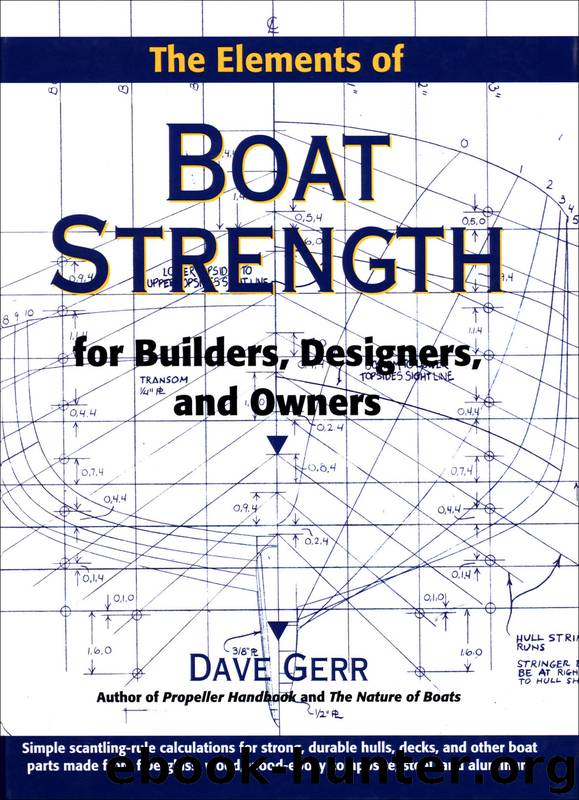The Elements of Boat Strength by Dave Gerr

Author:Dave Gerr
Language: eng
Format: epub
Publisher: McGraw-Hill Education
Published: 2000-02-25T16:00:00+00:00
• Silicon bronze and 316 stainless steel (second best) are the proper materials for metal-strap floors. Hot-dip galvanized mild steel, primed and painted all around before installation, can be used; however, it seems a poor economy after adding in the cost of galvanizing and painting and its lower life expectancy.
• Through-bolt the metal-strap floor into each stringer and into the keel.
• Through-bolt the metal-strap floor through the wood blocking and into the plank. On hulls with Sns less than 2, it may be easier to screw-fasten the blocking to the plank from outside, and then to screw-fasten (or lag-bolt) the metal strap down into the blocking from inside.
Install wood blocking under the metal strap at the same height, or a little higher, then the keel top athwartships. The blocking should be sided the same as the metal strap. Run the blocking out over the first stringer, out from the keel, and then taper the blocking height until it reaches the second stringer out and butts against it, flush with the stringer’s top. The metal-strap floor runs on top of the blocking continuously from port to starboard. On sailboats, at the ballast keel and the mast steps, the blocking should be extended out to the third stringer out from the keel (or farther). The blocking height—outboard of the second stringer—will be the same height as the stringers, and the metal strap will extend out over the third stringer.
If Logger Bobber were fitted with metal-strap floors, we would install
Download
This site does not store any files on its server. We only index and link to content provided by other sites. Please contact the content providers to delete copyright contents if any and email us, we'll remove relevant links or contents immediately.
The River by Peter Heller(2258)
Breath by James Nestor;(2232)
Sea Survival Handbook by Keith Colwell(2199)
Fatal Storm by Rob Mundle(2175)
Deep by James Nestor(2142)
Lonely Planet Australia by Lonely Planet(2034)
Iced In by Chris Turney(1960)
Discover Australia by Lonely Planet(1906)
Lonely Planet Maldives (Travel Guide) by Planet Lonely & Masters Tom(1800)
One Girl One Dream by Dekker Laura(1639)
Looking for a Ship by John McPhee(1630)
Chicken Soup for the Ocean Lover's Soul by Jack Canfield(1603)
Ten Degrees of Reckoning: The True Story of a Family's Love and the Will to Survive by Hester Rumberg(1602)
Lonely Planet Australia (Travel Guide) by Lonely Planet & Lonely Planet(1553)
South with the Sun by Lynne Cox(1542)
The Wave In Pursuit of the Rogues, Freaks and Giants of the Ocean(1507)
Diver Down by Michael Ange(1471)
Marlinspike Sailor's Arts and Crafts by Barbara Merry(1455)
The Golden Rules: 10 Steps to World-Class Excellence in Your Life and Work by Bob Bowman & Charles Butler(1434)
